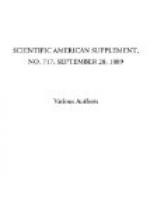The propeller shaft is generally made of iron, and if made not less than the Board of Trade rules as regards diameter, of the best iron, and the gun metal liners carefully fitted, they have given little trouble; the principal trouble has arisen from defective fitting of the propeller boss. This shaft working in sea water, though running in lignum vitae bearings, has a considerable wear down at the outer bearings in four or five years, and the shaft gets out of line. This wear has been lessened considerably by fitting the wood so that the grain is endway to the shaft, and with sufficient bearing surface these bearings have not required lining up for nine years. It is, however, a shaft that cannot be inspected except when in dry dock, and has to be disconnected from the propeller, and drawn inside for examination at periods suggested by experience. Serious accidents have occurred through want of attention to the examination of this shaft; when working in salt water, with liners of gun metal, galvanic action ensues, and extensive corrosion takes place in the iron at the ends of the brass liners, more especially if they are faced up at right angles to the shaft. Some engineers have the uncovered part of the shaft between the liners, inside the tube, protected against the sea water by winding over it tarred line. As this may give out and cause some trouble, by stopping the water space, I have not adopted it, and shall be pleased to have the experience of any seagoing engineer on this important matter. A groove round the shaft is formed, due to this action, and in some cases the shaft has broken inside the stern tube, breaking not only it, but tearing open the hull, resulting in the foundering of the vessel. Steel has been used for screw shafts, but has not been found so suitable, as it corrodes more rapidly in the presence of salt water and gun metal than iron, and unless protected by a solid liner for the most part of its length, a mechanical feat which has not yet been achieved in ordinary construction, as this liner would require to be 20 ft. long. I find it exceedingly difficult to get a liner of only 7 ft. long in one piece, and the majority of 6 ft. liners are fitted in two pieces. The joint of the two liners is rarely watertight, and many shafts have been destroyed by this method of fitting these liners.
I trust that engine builders will make a step further in the fitting of these liners on these shafts, as it is against the interest of the shipowner to keep ships in dry dock from such causes as defective liners, and I think it will be only a matter of time when the screw shaft will be completely protected from sea water, at least inside the stern tube; and when this is done, I would have no hesitation in using steel for screw shafts. Though an easier forging than a crank shaft, these shafts are often liable to flaws of a very serious character, owing to the contraction of the mass of metal forming the




